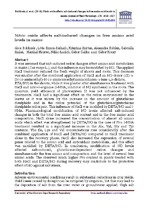| dc.contributor.author | Boldizsár, Ákos | |
| dc.contributor.author | Simon-Sarkadi, Livia | |
| dc.contributor.author | Keyster, Marshall | |
| dc.contributor.author | Ludidi, Ndiko | |
| dc.date.accessioned | 2017-09-08T12:06:11Z | |
| dc.date.available | 2017-09-08T12:06:11Z | |
| dc.date.issued | 2013 | |
| dc.identifier.citation | Boldizsár, Á. et al. (2013). Nitric oxide affects salt-induced changes in free amino acid levels in maize. Journal of Plant Physiology, 170: 1020-1027 | en_US |
| dc.identifier.issn | 0176-1617 | |
| dc.identifier.uri | http://dx.doi.org/10.1016/j.jplph.2013.02.006 | |
| dc.identifier.uri | http://hdl.handle.net/10566/3181 | |
| dc.description.abstract | It was assumed that salt-induced redox changes affect amino acid metabolism in maize (Zea mays L.),
and
this influence may be modified by NO. The applied NaCl treatment reduced the fresh weight of shoots
and roots. This decrease was smaller after the combined application of NaCl and an NO-donor
((Z)-1-[N-(2- aminoethyl)-N-(2-ammonioethyl)amino]diazen-1-ium-1,2-diolate, DETA/NO) in the shoots,
while it was greater after simultaneous treatment with NaCl and nitro-l-arginine (l-NNA, inhibitor
of NO synthesis) in the roots. The quantum yield efficiency of photosystem II was not influenced by
the treatments. NaCl had a significant effect on the redox environment in the leaves as it was shown
by the increase in the amount of glutathione disulphide and in the redox potential of the
glutathione/glutathione disulphide redox pair. This influence of NaCl was modified by DETA/NO and
l-NNA. Pharmacological modification of NO levels affected salt-induced changes in both the total
free amino acid content and in the free amino acid composition. NaCl alone increased the
concentration of almost all amino acids which effect was strengthened by DETA/NO in the case of
Pro. l-NNA treatment resulted in a significant increase in the Ala, Val, Gly and Tyr contents. The
Ile, Lys and Val concentrations rose considerably after the combined application of NaCl and
DETA/NO compared to NaCl treatment alone in the recovery phase. NaCl also increased the expression
of several genes related to the amino acid and antioxidant metabolism, and this effect was modified
by DETA/NO. In conclusion, modification of NO levels affected salt-induced, glutathione-dependent
redox changes and simultaneously the free amino acid composition and the level of several free
amino acids. The observed much higher Pro content in plants treated with both NaCl and
DETA/NO during recovery may contribute to the protective effect of NO against salt stress. | en_US |
| dc.language.iso | en | en_US |
| dc.publisher | Elsevier | en_US |
| dc.subject | Free amino acid | en_US |
| dc.subject | Glutathione | en_US |
| dc.subject | Nitric oxide | en_US |
| dc.subject | Maize | en_US |
| dc.subject | Salt | en_US |
| dc.title | Nitric oxide affects salt-induced changes in free amino acid levels in maize | en_US |
| dc.type | Article | en_US |
| dc.privacy.showsubmitter | FALSE | |
| dc.status.ispeerreviewed | TRUE | |
| dc.status.ispeerreviewed | This is the author-version of the article published online at: http://dx.doi.org/10.1016/j.jplph.2013.02.006 | |
| dc.description.accreditation | Web of Science | |

